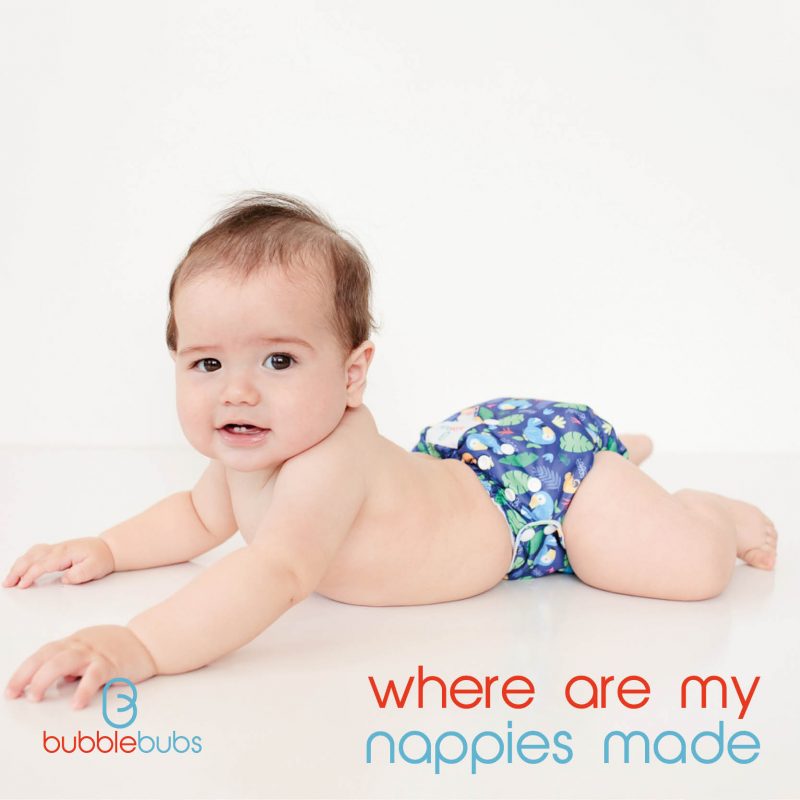
Where Do My Cloth Nappies Come From?
A Question of Ethics: Where Do My Nappies Come From?
In a throwaway society of fast fashion it’s certain that, as parents, we need to be more mindful of the planet we are leaving behind for our children. A huge part of this is thinking about where our clothing is being produced and the quality of workmanship that will mean it lasts for more than five minutes. Sure, you can buy cheaply, but six tonnes of clothing goes to landfill every minute in Australia!
So, what about Cloth Nappies? Some families choose to use reusable nappies because they have less of an impact on landfill; if they are of good quality they can be sold or passed on to another family which not only reduces their environmental impact but also helps their hip pocket as second (or even third or forth) hand MCNs can be used over and over again. That’s why it can be just as important to invest in good quality nappies that are going to go the distance, otherwise, how are they any different to disposables going into landfill?
But hang on. Aren’t these “good quality” reusable nappies still made in China, just like the so-called “China Cheapies”? How are they any better? The environment is one thing, but if we’re paying triple the money how can we be sure that the nappies we buy are ethically produced? Environmental responsibility and social responsibility aren’t mutually exclusive; it is just as necessary to think about where our modern cloth nappies are coming from as it is to think about where they will go once we are done with them.
Vicki, owner at Bubblebubs Modern Cloth Nappies, has always been open about the origin of production of her nappies. What started out as a backyard business where she would make the product herself has led to an ongoing crusade to get as many families into cloth as possible. While there are WAHMs (Work At Home Makers) who still produce small batch nappies locally, many of the big Australian brands have moved production offshore. One of the main reasons for offshore production is the cost and volume of product required. For Bubblebubs, the experience is that mass production in Australia is just not financially viable if reusable nappies are to be made accessible to more families. There is no manufacturer in Australia who can currently produce modern cloth nappies to the standard required, let alone produce the amount needed to keep up with demand and regular seasonal releases.
Let’s talk factories then. When you think of factory production, visions of huge industrial blocks filled with automaton workers, mindlessly sewing for a few pennies an hour might fill your imagination. Whilst this can certainly be the case, Vicki has visited the factories responsible for making Bubblebubs’ award winning Candies, among other products, twice now, with an aim to view samples, meet with the managers and workers, and build an understanding and respect for different cultures in her own children. Whilst there she posted several videos on social media allowing customers insider access to the factory floor and those who work there.
Vicki has always been incredibly transparent with the manufacturing of Bubblebubs products and strongly believes in being open about offshore production. Not only that but she works very closely with the employees to ensure that the conditions do indeed live up to the high standards expected of them. The Bubblebubs factories are away from the hustle and bustle of the big cities, in “country China” giving workers the opportunity to stay closer to home to work, rather than move to factory style apartments in major cities. Some of the men and women who work in the factories are even couples from the same family and are able to work hours around caring for their young children by having opposite shifts.
When you see the videos of the workers snapping and sewing away, they are jovial and more than happy to interact with the camera, have a laugh with Vicki and partake in the TimTams and other delectable Aussie delights she brings as gifts for the workers.
One great story is of a local Aussie mum who found a Candie with a coin sewn into the lining. Upon dissection it was found to be a Chinese Yuan that an employee had put in for good luck whilst manufacturing at Chinese New Year. The fact they did that speaks volumes in itself that they’re putting lucky coins in nappies and not 'help me notes'!
While China Cheapies certainly have their place, and often mean more bums in cloth, it’s still important to know that some “Australian” nappies are re-branded Chinese nappies created by picking and choosing from a standard design menu, then selling at an inflated price. Others are just stock standard Chinese made nappies that are the same design but with a different label across multiple brands. Not knowing where your nappies come from can cause trouble down the track with possible leaking, poor elastic life, or delamination of the PUL. If you’re going down that route, it definitely pays to do your research on the company and ensure that you’re getting what you pay for.
Ways to find out more about brands of nappies are to read reviews online or join review groups on Facebook and search or ask questions about specific brands. The Australian Nappy Association is also a good starting place for information. Additionally, you might consider contacting the company directly to ask what they know about their own production system and see how involved they are in the manufacturing process.
When it comes to cloth, cheap can be functional; however, it can come at an ethical price. It definitely pays to do your research and to know where your modern cloth nappies are manufactured. That way you can be sure you’re not only doing your bit for the planet, but also your conscience.
By Katherine Edwards
